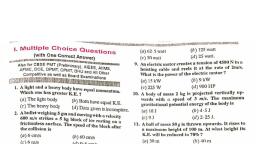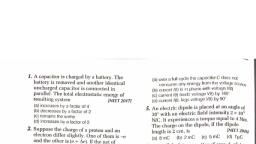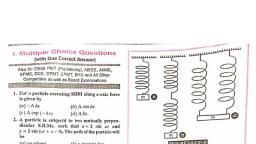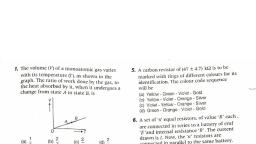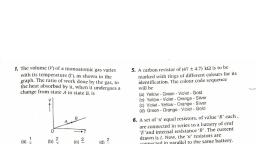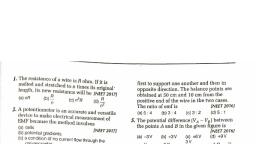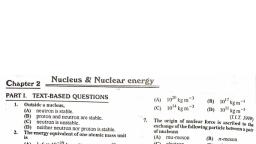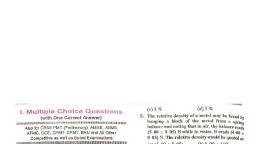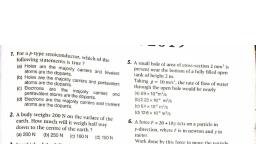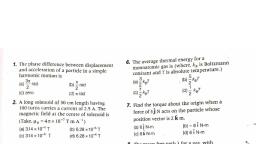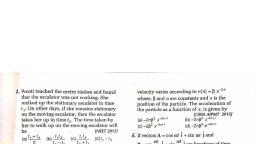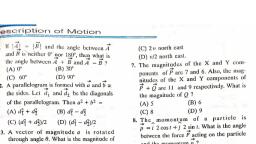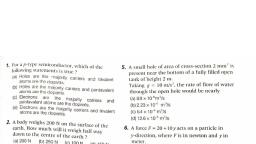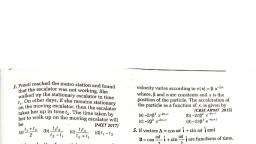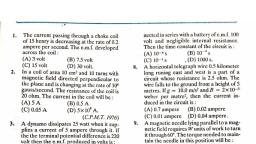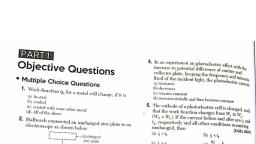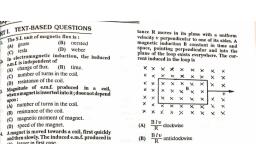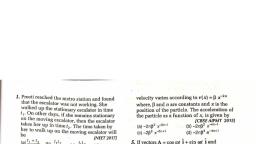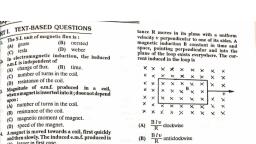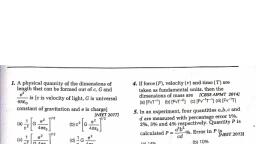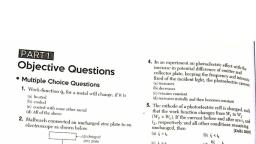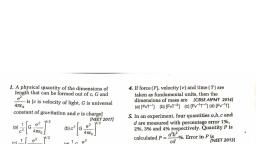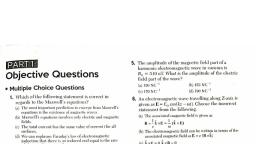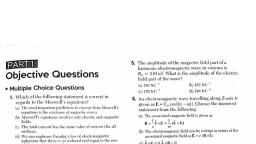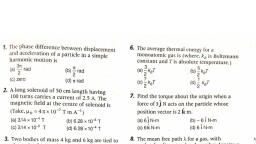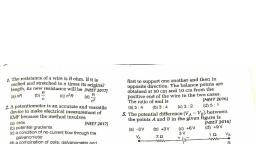Page 1 :
Objective Questions, , ¢ Multiple Choice Questions, , 1. Which of the following statement is correct in, , regards to the Maxwell's equations?, , (a) The most important preiiction to emerge from Maxwell's, equations ts the existence of magnetic, , th) Maxwell's equations invelves only clectric and magnetic, fields., , {e) The total current has the same value of current ifor all, surfaces,, , {d) We can rephrase Faraday’s law of clectromarnetic, induction that there is wn induced emf equal to the rate, of change of magnetic Mus., , , , 2. The electric field of an electromagnetic wave, travelling through vacuum is given hy the equation, E= Ky sin (kx et}. The quantity that is, independent of wavelength is, , fa) th) ke, «, , fe} {dk, 3. The electric and the magnetic fields, associated, with an electromagnetic wave, propagating along, the + Y-axis, can be represented by, (a) (E« Ky k, B= Byi), (b)(E=E, jp B= By i), ()( = Ey j, B= By k), (@)(E = Fy i, B= By 1), 4. Light wave is travelling along y-direction. If the, , corresponding E vector at any time is along the, X-axis, the dircetion of B vector at that time is along, , 0, , , , , , (b) X-axis, , fa) Y-axis (a) -Z-uals, , {c} + Z-axis, , 5. The amplitude of the magnetic field part of a, harmonic electromagnetic wave in vacuum is, By = 510 nl. What is the amplitude of the electric, licld part of the wave?, fa} a0 NC*, () 170NCT, , (b) 153 NC!, (d) 19a NC, 6. An electromagnetic wave travelling along Z-axis is, given as E = E, cos{kz - mt), Choose the incorrect, statement from the following., {a} The associated! magnetic field és ative as, B= kxp=4 (xB), © o, (b) The clectromagnetic field can be written in terms af the, associated magnetic field as E = ¢(B xk), (co) kxB=OkxB<0, (d) None of the abave, T. A plane electromagnetic wave of frequency, 25 GHz is propaguting in vacuum along the, s-direction, Ata particular point in space and time,, the magnetic field is given by B =5 x 107"). The, corresponding electric field E is (Take, speed of, light, c= 3x 10" ms!), {a} - 1.661079 Vin, (b) 1.66 «1077 vm, {c} 155 Vor!, id) 15 i vm", , 8. Suppose that, the amplitude of electric field of an, electromagnetic wave is Ey = 120 NC™! and its, frequency is v=50.0 MHz. ‘The expressions for E, will be (if wave travels along X-axis), , (aj (M20 NC} sin (11.05 vad mm) x, = (9.6 108 rad s*)6))1, , (b) [120 NG") sin {(1.05 rad an", = 3.1 10" rads") #)], , (e) (120 NG") sin {41.05 rad an hx, = (3.14 10° rads 8) 0), , {dt} [20 NC™) eos ((L.05 rad myx, ~ (3.14% 10" rack sy 0h j
Page 2 :
9 Which two of the following five physical, , parameters have the same dimensions?, (i) Energy density (CBSE AIPMT 2008], {ii) Refractive index, , {iii) Dielectric constant, , (iv) Young's modulus, , {v) Magnetic field, , {a) (ii) and {iv) (b) (li) ane (vp, , {c) (@) and {iv) (gd) (i) and {v), , 10. if the error in the measurement of radius of, a sphere is 2%, then the error in the, determination of volume of the sphere, will be (CBSE AIPMT 2008), (a) 4% (b) 6% (c) 8% (d) 2%, , 11. Dimensions of resistance in an electrical, circuit, in terms of dimension of mass M, of, length L, of time T and of current J, would, be {CBSE AIPMT 2007], (a) [METI] (o) [MLT?], , (c) [ML°T-'-") (a) [MET4-2], , 12. The velocity v of a pom at time t is, given by uv = at + Ti , where a,b and ¢ are, c, , constants. The dimensions of a,b andc are, respectively [CBSE AIPMT 2006], (a) (LT~), (LJ and [7] (b) (L), (7) and [LT?), (c) (LT?}, [LT] and (L} (A IL], [LT] and [1], , 13. The ratio of the dimensions of Planck's, constant and that of the moment of inertia, is the dimension of [CBSE AIPMT 2005], (a) frequency (b) velocity, (c) angular momentum (dq) time, , 14. The dimensions of universal gravitational, , constant are [CBSE AIPMT 2004, 1992], (a) (MT?) (b) (ML7T-"}, (c) [M*L3T*) (@) (M"L7T'], , 15. The unit of permittivity of free space, €, is, , (a) coulomb/newton-metre [CBSE AIPMT 2004], (b) newton-metre /coulomb?, , (c) coulomb? ‘newton -metro?, (d) coulomb? ‘(newton -metre)*, 16. The value of Planck's constant in SI unit is, , (a) 663 x 10" Js [CBSE AIPMT 2002], (b) 663 x 10° kg -m/s, , (c) 663 x 10°” kg-n?, (a) 663 x 10 J-s, , 17. Planck's constant bay the, , (2) lineat momentum, (b) angular momentum, (c) energy, , (d) power, , dimensions, ICASE Atpagy 2m), , 18., , A pair of physical quantities jy., dimensional frank oe P, (a) force and torque, , (b) work and energy, , (c) force and impulse, , (d) linear momentum and angular Momentum, , 19. The dimensional for, flux is, , TB Same, AIPMT 200%), , mula for magnetic, , ICBSE Aj, (a) (MUTA) (b) Mista) Ve99), (c) [ML T?a-2) (a) (ML2T*A2y, , 20. The force F on a sphere of radius movi, in a medium with velocity v is given by, F = 6 nrv. The dimensions of qare, , [CBSE AIPMT 199;, (a) [ML] (b) [ML] (e) [MT] (a) [MeL 1", , 21. Which of the following will have the, dimensions of time ? [CBSE AIPMT 1996), , a L c, a) LC b) — = =, (a) a @e @:, , 22. The density of a cube is measured by, measuring its mass and length of its sides., If the maximum error in the measurement, of mass and length are 4% and 3%, respectively, the maximum error in the, measurement of density will be, [CBSE AIPMT 1996}, , (c) 12% (d) 13%, , {a) 7% (0) 9%, , 23., , ae a )\_» 6, An equation is given as| p + ohn v", where p = pressure, V = volume and, @ = absolute temperature. If aand b are, constants, then dimensions of a will be, , [CBSE AIPMT 1996], (a) [MET] (b) (MET?), (c} [MUST] (IMT), , 24, The percentage errors in the ens, of mass and speed are 2% an respectively. The error 1" kinel a, , ss and speed,, , obtained by measuring Case PMT 1995], , will be (ex (6) 2%, , (a) 12% — (b) 10%
Page 3 :
25., , Which of the following is a dimensional, constant ? [CBSE AIPMT 1995], (2) Refractive index (b) Poisson's ratio, , (c} Relative density {(d) Gravitational constant, , 26. In a vernier calipers N divisions of vernier, , 8, , scale coincide with N - 1 divisions of main, , scale (in which length of one division is, , 1 mm). The least count of the instrument, , should be [CBSE AIPMT 1994], , (a) N WN-1 gt gt, 1ON 6 Wi -1, , Ina particular system, the unit of length,, mass and time are chosen to be 10 cm, 10 g, and 0.1 s respectively, The unit of force in, , _ this system will be equivalent to, , 28., , 29., , 30., , 31., , [CBSE AIPMT 1994], ()1N = (c}10N — (d) 100N, Turpentine oil is flowing through a tube of, length / and radius r. The pressure, difference between the two ends of the, tube is p. The viscosity of oil is given by, p(t -x), , aul, , where, v is the velocity of oil at distance x, from the axis of the tube. The dimensions, of nare [CBSE AIPMT 1993], , (a) [M2L°T®) (b) [MLT"] (c) (ML?T*] (@) [IML"T*}, , ‘The time dependence of physical quantity, pis given by p = po exp (- at”), where a is, , a constant and¢t is the time. The constant a, {CBSE AIPMT 1992], , (a) is dimensionless (b) has dimensions [T*], (c) has dimensions [T*] (d) has dimensions of p, , (a) 0.1.N, , n=, , If p represents radiation pressure, ¢, represents speed of light and S represents, radiation energy striking unil area per sec., The non-zero integers x, y,z such that, , p*s’c*is dimensionless are, [CBSE AIPMT 1992], (o)x=-ty=1z=1, , elysiz=1, faxety - ixety=tz=-1, , ()x=ty=-1z=1, The dimensional formula for permeability, of free space, [lp is [CBSE AIPMT 1991), , LTA] (b) (ML TA], ye ML TAP) (0) [MLT?A*}, , 32,, , 33., , x, , 35., , 56., , 37., , 38., , 59., , A certain body weighs 22.42 g and has a, measured volume of 4.7 cc. The possible, error in the measurement of mass and, volume are 0.01 g and 0.1 cc. Then,, maximum error in the density will be, , ICBSE AIPMT 1991}, (a) 22% (b) 2%, (c) 0.2% (d} 0.02%, , The frequency of vibration f of a mass m, , suspended from a spring of spring constant, & is given by a relation of the type, f =Cm*k", where C is a dimensionless, , constant, The values of x and y are, , ‘ 1 t a sailed 1990), Okmai "2 ee, aya djxe-t yet, (c) x y= 5 (d) x a y =, , According to Newton, the viscous force, acting between liquid layers of area A and, , velocity gradient = is given byF =- nA a,, where nis constant called [CBSE AIPMT 1990}, (a) [(MLPT?)] fo) [MPL°T?] (c) [ML?T-* ](d) [ML“'T*], , The dimensional formula of pressure is, [CBSE AIPMT 1990), (a) [MLT*] | (b) [ML>'T®} (c) [ML“'T-*} (d) [MLT*}, , The dimensional formula of torque is, [CBSE AIPMT 1989}, , (a) [MT] (b) [MLT?], , (c} (ML"T*] (MFT }], , If x= at + bt®, where x is the distance, travelled by the body in kilometer whilet, is the time in second, then the unit of b is, , [CBSE AIPMT 1989], (a)km/s (b)km-s —(c)km/s*—(d) kms?, Dimensional formula of self-inductance is, , {CBSE AIPMT 1989], , (a) [MUTA] (b) (ML-T'A*), (co) (ML2T 2A] (@) (META), , Of the following quantities, which one bas, dimensions different from the remaining, three? [CBSEAIPMT, , (a) Energy per unit volume, , (b) Force per unit area, , (c} Product of voltage and charge Pe, (d) Angular momentum, , unit volume, , ™ >
Page 4 :
40., , 41,, , 42,, , 43., , A beam of electrons is moving with, constant velocity in a region having, simultaneous perpendicular electric and, magnetic fields of strength 20 Vm7 and, 0.5 T, respectively at right angles to the, direction of motion of the electrons. Then,, the velocity of electrons must be, , [CBSE AIPMT 1996], (2) 8ms_— (b) 20 m/s (c) 40 mis (d) a ms, , The magnetic field dB due to a small, , element at a distance r and carrying, current j is, , [CBSE AIPMT 1996], , (a) dB = Ho ; (=), , 4n r, (bo) dB = Ho 2 (), , 40 r, (c) dB = Ho j2 (~), , 4n r, (0) dB = Ho | (Ss), , 4n P, , A 10 eV electron is circulating in a plane at, Tight angle to a uniform field of magnetic, induction 10° * Wh/m? (= 1.0 gauss). The, orbital radius of the electron is, , [CBSE AIPMT 1996], (c)11em (d) 18cm, At what distance from a long straight wire, carrying a current of 12 A will the magnetic, field be equal to 3 x 107° Wb/m? ?, , (a) 12cm = (b) 16cm, , [CBSE AIPMT 1995], (a) 8x10 m (b) 12 x 107 m, (c) 18 x 10 m (d) 24 x 10% m, , A straight wire of diameter 0.5 mm, carrying a current of 1 A is replaced by, another wire of 1 mm diameter carrying, same current. The strength of magnetic, field far away is ICBSE AIPMT 1995], (a) twice the earlier value, , (b) same as the earlier value, (c) one-half of the earlier value, (d) one-quarter of the earlier value
Page 5 :
45. A proton and an a-particle are accelerated, from rest to the same energy. The de-Broglie, , wavelengths A, and A,, are in the ratio, (a) 2:1 (b) 1:1 (c) v2:1 (d) 4:1
